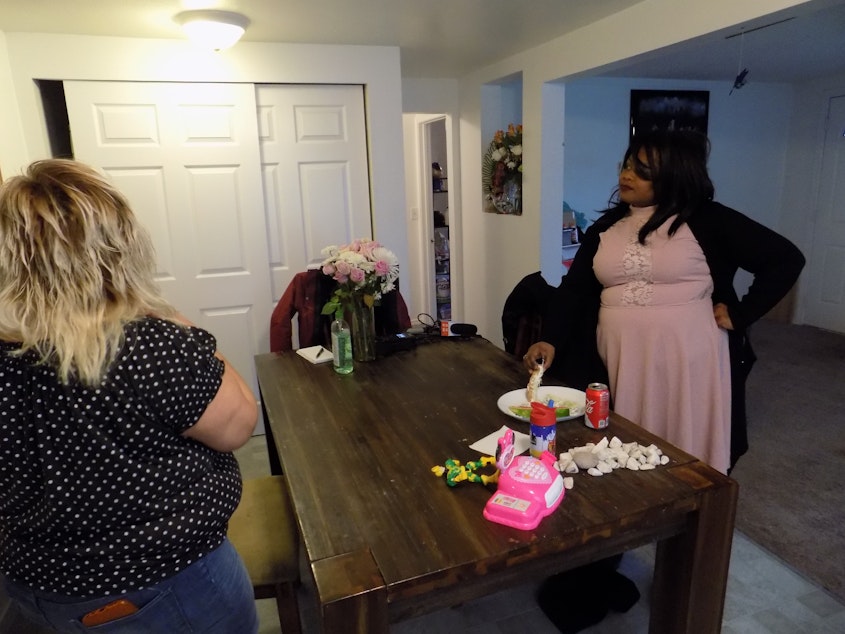Thousands have avoided homelessness thanks to new initiative, King County says

Vera Page’s office is her car, a Chevrolet HHR. Her two phones chime and chirp as she sits parked in Seattle’s Capitol Hill neighborhood. Many of the calls she receives every day are from families in crisis, looking to Page for help.
That’s because Page’s job is to catch young people and families at the edge of homelessness and stop them from tipping over that edge.
She’s a case manager for All Seattle Kids Home, one of 25 agencies getting a grand total of $19 million over six years through the King County Youth and Family Homelessness Prevention Iniative, part of the Best Starts for Kids levy.
Page takes her job seriously.
“I’m a tall cup of coffee. Even if I’ve only had the family for one intake, it is a promise that when I get through with them something is going to change.”
Sponsored
County officials say the initiative has exceeded expectations in its first year.
“We know of the just over 1,000 households served, which is 3,000 clients, that 96 percent have been able to maintain their housing and avoid an episode of homelessness,” said Hedda McLendon, who leads the initiative for the King County Department of Community and Human Services.
The accuracy of that statistic is unknown, because the county tracks success by checking whether clients in their prevention program later show up in their homeless service system. If clients become homeless elsewhere, or don’t access services, the county wouldn’t necessarily know that they’d lost their housing.
Still, the data from the first nine months of the initiative are promising, McLendon said.
What's special about this approach, county officials say, is that case managers like Page have the flexibility to address the specific needs of the people they work with. They can negotiate with landlords, help families with things like budgeting or job training, and connect them with available resources like utility discounts and food stamps.
Sponsored
“I pride myself on being the diva of finding resources. And I also pride myself on being that case manager that speaks to 'no case too tough,'” Paige said.
Case managers also have access to cash assistance that can be used for anything that might help a client stay housed, like repairing a vehicle so parents can get to work, paying back rent, and paying overdue bills.
Page said there’s far more need than the resources available, and she turns to her organization's pot of county funds as a last resort. “After all of my cards are played, and there is nothing left, bam! Financial assistance.”
Despite limited resources, Page said, she feels the prevention work is having an impact. “Because we really, really target people who have no other options but to land in the streets or in shelters, in that way I think we’re making a very big difference."
She also sees challenges with the county’s initiative. Page experienced homelessness as a teenage mom, and knows there’s no cut-and-dried formula to working out whether a family is at imminent risk of losing their housing.
Sponsored
“I think that maybe the rules that govern who we help are maybe just a slight bit rigid. Because sometimes homelessness prevention looks different," Page said.
McLendon said that’s a tough part of programs like this. But she said a lot of time was spent in the first year of the initiative working with providers to determine how best to identify people at imminent risk of homelessness.
“We are doing an excellent job of identifying populations that we know are at higher risk of experiencing homelessness, and providing supports to them in their communities,” McLendon said.
Currently, both Seattle and King County only earmark a fraction of their overall homelessness funding for prevention. But McLendon said intervening before someone loses housing is much less expensive. And that even a short stint on the streets can have an immense impact, especially on young people.
“Even one day of homelessness is huge. When you look at studies locally, it shows that a quarter of chronically homeless adults actually experienced homelessness as a young person. So for us, being able to prevent somebody from even facing the hardships that result in homelessness is equally important as also working to solve people who have experienced homelessness,” McLendon said.
Sponsored
Suzanna Mak is the executive director of All Seattle Kids Home. While this prevention work is critical, Mak said, she worries that it could be seen as a silver bullet.
“Prevention may have been achieved for that moment in time,” said Mak. But, she said, that doesn't ensure secure housing into the future.
Mak said her organization is allowed to help families repeatedly, if necessary, and sometimes they do. “What families need are additional resources to continue to help stabilize them, because we cannot help them long-term," Mak said.
Seattle Mayor Jenny Durkan agrees that more work needs to be done upstream.
“One of the most critical things I believe we do to prevent homelessness is to build economic opportunity," Durkan said. "If we build wealth in the communities that are most disadvantaged, if we build wealth in those communities that are being displaced, then we will be ahead of the game.”
Sponsored
Durkan said she wants to see more focus on prevention throughout the region. At last count, 11,643 people were homeless countywide.
For now, King County officials say they may expand funding for their Youth and Family Prevention Initiative. But they want to be sure it’s truly effective before making that call. While there’s not a lot of research on the efficacy of homelessness prevention, researchers at MIT and Notre Dame have chosen the county’s initiative for an academic study on the effectiveness of such strategies.
